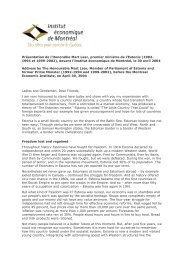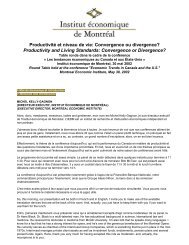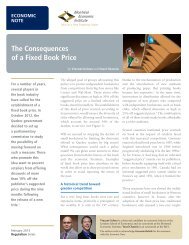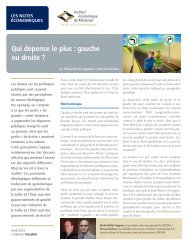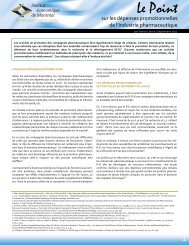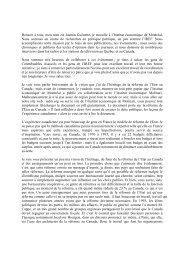Union certification: Developing a level playing field ... - LabourWatch
Union certification: Developing a level playing field ... - LabourWatch
Union certification: Developing a level playing field ... - LabourWatch
Create successful ePaper yourself
Turn your PDF publications into a flip-book with our unique Google optimized e-Paper software.
<strong>Union</strong> <strong>certification</strong>: <strong>Developing</strong> a <strong>level</strong> <strong>playing</strong> <strong>field</strong> for labour relations in Quebec1. <strong>Union</strong>izationin Canada andother developedcountriesThe density of trade union membership hasbeen declining in most member countries of theOrganisation for Economic Co-operation andDevelopment (OECD) since 1980. 1 In the UnitedStates, 22.3% of employees were trade unionmembers in 1980, compared to 11.6% in 2007(ranging from 3.9% in North Carolina to 26.3%in New York State). A similar trend occurred inthe United Kingdom, where trade unionmembership reached 50.7% of employees in 1980and declined to 28% in 2007. Besides thesecountries, significant reductions in trade uniondensity also occurred elsewhere, notably inAustralia, Austria, France, Germany, Ireland, Italy,Japan, Korea, the Netherlands, New Zealand,Portugal, and Switzerland. Trade union densityremained about the same in Belgium, Finland,Norway, and Sweden. In Canada, trade uniondensity reached 34.0% in 1980, but declined to29.4% in 2007. Hence, as compared to the U.S.,the U.K. and many other OECD countries, tradeunion membership in Canada declined butremained relatively steady throughout the period.The situation in Canada 2According to Statistics Canada, 3 unions had4.23 million members on average in the first sixmonths of 2008. Meanwhile, 4.54 millionemployees on average were covered by collectiveagreements during the same period. Thisdifference, as illustrated by the distinctionbetween union membership and union coverage,can be explained by the fact that some employeeswho are not union members are coverednonetheless by collective agreements. On anannual basis, 31.5% of Canadian employees werecovered by collective agreements in 2007, downfrom 33.7 % in 1997.<strong>Union</strong> coverage rates are higher in the publicsector—particularly in educational services,utilities, public administration, and health careand social assistance—as well as in full-time jobsand among employees in larger workplaces.According to Statistics Canada, 4 unionmembership and coverage rates were respectively71.0% and 74.5% in the public sector and 16.3%and 17.9% in the private sector. These rates wererespectively 52.0% and 54.8% in workplaces withmore than 500 employees and 12.6% and 14.2%in those with less than 20 employees. These job,worker and workplace characteristics areassociated with higher earnings, which mayexplain in part the higher pay reported byunionized employees. Collective bargaining onbehalf of unionized employees may also partlyexplain their higher pay.1. OECD, Trade union density in OECD countries (1960-2007),http://www.oecd.org/dataoecd/25/42/39891561.xls.2. This section is based, sometimes verbatim, on data from HumanResources and Social Development Canada, <strong>Union</strong> membership inCanada—2008, http://www.hrsdc.gc.ca/eng/labour/labour_relations/info_analysis/ union_membership/index.shtml and on StatisticsCanada, <strong>Union</strong> coverage rates, http://www.statcan.gc.ca/pub/71-222-x/2008001/sectionk/k-rates-taux-eng.htm.3. Statistics Canada, “<strong>Union</strong>ization,” Perspectives on Labour and Income,Vol. 9, No. 8 (August 2008), Catalogue No. 75-001-X.4. Id.Montreal Economic Institute9



